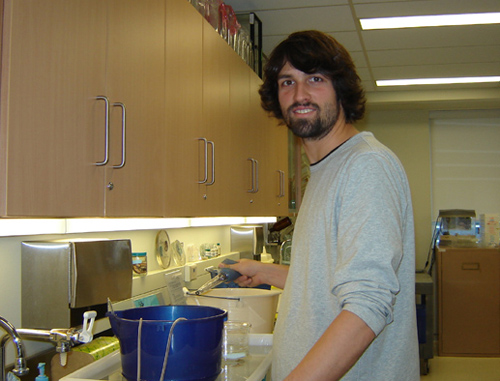
That’s not just any shrimp filling the big screen in a Guelph high school classroom. It’s the mantis shrimp, tiny but mighty. The creature’s secret weapon is its claw, whose prey-pulverizing motion ranks among the wonders of the animal world, says U of G master’s student Liz Johnston.
She and PhD student Andy Turko left behind their campus labs one day last week to visit senior biology students at John F. Ross CVI. That was one of several outreach visits to Guelph high schools by U of G graduate students in the Department of Integrative Biology. They talked about biology studies and a public lecture taking place on campus next week.
Sheila Patek, a biology professor at the University of Massachusetts-Amherst, will speak on “Sudden and Swift: Extreme Movements in Biology.” Her free public lecture will take place May 14 at 6 p.m. in Rozanski Hall. The event will occur during the Canadian Society of Zoologists (CSZ) annual meeting May 13 to 17, which will attract about 400 North American scientists to Guelph.
Speaking to one Grade 12 biology class at John F. Ross, Johnston draws appreciative murmurs from her listeners as she describes Patek’s studies of arthropod motion and sound. The ocean-dwelling mantis shrimp wields its claw to crack open shells of clams, snails and other mollusks.
It’s tough and fast.
Playing a video clip of the action, Johnston points out a flash of light on the screen. The strike generates cavitation bubbles between the claw and the prey. In a phenomenon called sonoluminescence, shock waves from the impact can generate bursts of light from those collapsing bubbles. “It’s so fast and furious that it actually produces light,” says Johnston.
Larger species can even crack aquarium glass, adds Turko.

Studying movement in arthropods, including mechanics and sound, might yield ideas for scientists studying evolution or engineering, says Johnston. In bio-inspired design, or biomimicry, scientists and engineers borrow nature’s designs to improve our own.
Look at Velcro, which mimics the stick-to-it-iveness of plant burrs. Or robots able to climb walls on gecko-style suction feet. Or swimsuits whose texture turns Olympians such as Ryan Cochrane and Michael Phelps into streamlined sharks in the water.
“A lot of really innovative ideas come from the natural world,” says Johnston, B.Sc. ’12. She’s a former competitive swimmer whose current aquatic pursuits include playing underwater hockey on campus, and she’s completing a master’s degree with integrative biology professor Todd Gillis, co-organizer of the CSZ conference next week.
Under the theme “Zoology for a Better Planet,” the meeting will include talks on biodiversity, conservation biology, wildlife ecology and environmental physiology. Among the speakers, integrative biology professor Paul Hebert will discuss measuring biodiversity and DNA barcoding.
From high school outreach to public lectures, says Gillis, university researchers need to talk to the public about their work and its relevance. “The work that biologists are doing is critical to understanding how we are impacting the environment and how changes in the environment are going to impact us.”
He says many of the delegates attending the meeting – including Guelph researchers – study the long-term consequences of environmental change. From physiology to ecology, “there will be an amazing diversity of research presented at this meeting by leading researchers from across Canada and North America.”
Gillis belongs to a research group spanning U of G’s College of Biological Science (CBS) and Ontario Veterinary College whose members look at heart disease, from single molecules to animal models.
In his lab, Johnston studies regulation of connective tissue in fish hearts. Rainbow trout can vary amounts of that tissue with environmental conditions, especially temperature. But in other animals, including humans, connective tissue permanently laid down after a heart attack can lead to further problems, including eventual heart failure. She hopes to learn more about what happens in fish hearts, information that might help in understanding healthy or diseased human organs.
“Extreme fish” also occupy Turko, B.Sc. ’08. He studies mangrove killifish with Prof. Pat Wright, also the Department of Integrative Biology. Turko’s project has taken the doctoral student to mangrove swamps in Belize and the Florida Keys, where the amphibious killifish lives in small pools.
Because of tides, weather and seasons, he says physical conditions for the creature are like a yo-yo. Temperatures move up and down within hours. Sometimes the water is practically devoid of oxygen. Hydrogen sulphide bubbles out from rotting mangrove leaves. Rainfall can make the burrows more like fresh water, and drought can render them super-salty.
Pushed to extremes, killifish can survive for weeks out of water in damp surroundings such as rotting logs. “This fish is really unique,” says Turko. “They’re tough as nails, they’re awesome. They’re really plastic and flexible: they can change so many aspects of their physiology in response to changing conditions.”
Learning about their shape-shifting tricks might help researchers in other fields from medicine to the conservation of other animals in changing environments, he says.
Several of the classroom listeners at John F. Ross plan to begin biology studies at U of G in the fall. Biology teacher Greg Staines says, “I think it’s important for the students to see there’s a continuation of their education that’s local – that they have this world-class facility in their own community, and that there’s top-notch research going on there.
“It also shows that what we’re trying to teach students at the high school level has relevance beyond the high school and has some real-world applications.”
A 1992 Guelph zoology grad, Staines has been back to campus to speak to students during CBS career nights.
Patek’s May 14 talk at Guelph is sponsored by the CSZ’s Zoological Education Trust and the Journal of Experimental Biology.